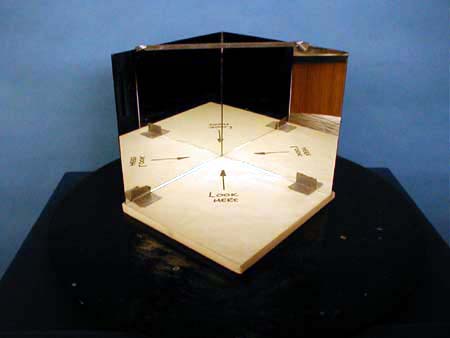Demos: 7A-07 Corner Reflector

Two mirrors are mounted at 90° to each other. Two effects may be demonstrated. (1) Any ray incident on one of the mirrors will emerge traveling parallel to the incident ray. (2) A consequence of the principle in (1) is that if an object is placed between the mirrors, the image viewed by looking into the intersection of the mirrors does not move when the system is rotated about a vertical axis.
Directions: Place the mirrors on the rotating turntable. Rotate the table and ask the students to observe their reflection seen by looking at the mirror intersection.
Suggestions for Presentation: As a follow-up to 7A - 06, you might use the laser and dust cloud to show that the incoming and outgoing rays are parallel. Then rotate the mirror table to show that the direction doesn’t change. This is the principle behind corner reflectors used in tail lights (and other reflective devices) and was used to reflect a laser beam sent ot the moon. The orientation of the corner reflector array was not critical. (In a true corner reflector, a third mirror at right angles to the other two is used so that light can come in from any angle and still work.)
A few students at a time can see their reflections in the mirror intersection. Have them notice that the image is truly reversed left-to-right in this case. If the student raises a right hand, the image raises a right hand! This really freaks them out! It is not what one observes in an ordinary mirror. You should also point out that this image is the way others see them.
Applications: Corner reflectors, multiple mirrors
Last Updated: Nov 30, 2023 11:25 AM